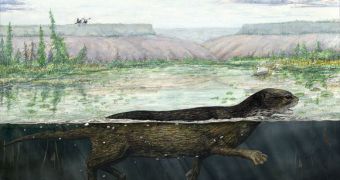Over the years, evolutionary biologists have often wondered about and sought for the missing link that connects land-based animals with the pinniped family, which contains seals, walruses and sea lions. Now, digging in the Canadian Arctic, researchers believe they may have discovered the animal from which the seals evolved. The new species, named Puijila darwini, has traits similar to otters and seals, and also webbed feet, which presumably allowed it to move through water and on land very easily.
The mammal, even though not directly related to the seal, has been dubbed the “walking seal.” According to experts at the Canadian Museum of Nature, the creature lived between 20 and 24 million years ago, most likely in and around fresh water lakes at medium to high latitudes. Its average body size was of just 110 centimeters from nose to tail, which made it a fairly small carnivorous predator. More details of the P. darwini are presented in the April 23rd issue of the journal Nature.
An animal known as Enaliarctos has been thus far the oldest precursor of seals ever found. Though it lived approximately in the same period as P. darwini, its feet were already replaced by flippers, and its body was more streamlined and adapted to living in the water. This type of construction most definitely allowed it to increase its speed when hunting underwater, which was more than certainly a great advantage and favored its evolution.
“It (Enaliarctos) doesn't tell us anything about how that lineage came to be. We know they came from land mammals. Our animal fills that transitional gap between the land form and the marine flippered form we're familiar with today,” Natalia Rybczynski, who is an expert at the Canadian Museum of Nature, explained for Reuters in an interview. She added that the fossils of P. darwini were first found in 2007, and that the remains were approximately 65 percent complete.
“Other mammals that went from land to sea, like whales and manatees, retained and made good use of their Tails, (which) became propulsive structures. For some reason, the pinniped lineage didn't do that, and now we know they had had the option; they had the tail but didn't use it,” Rybczynski shared. The newly discovered animal is believed to have had large canine teeth, adorning a very powerful jaw, which it used to crush its prey. Its snout was fairly short, which further added to the strength of its bite.

 14 DAY TRIAL //
14 DAY TRIAL //